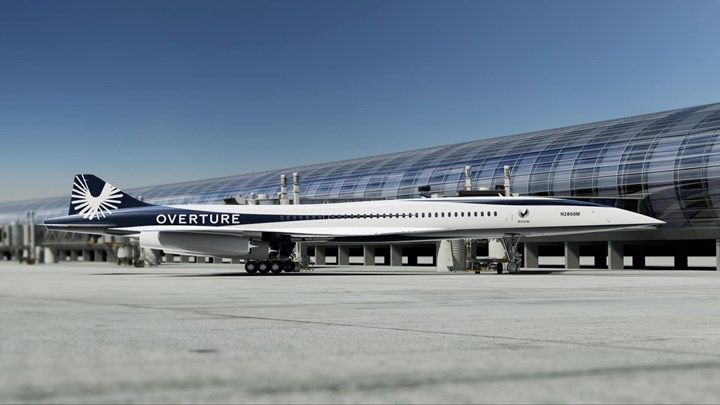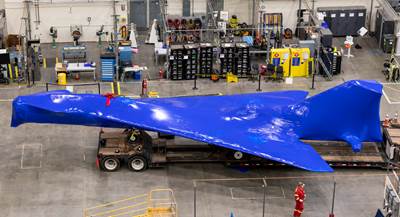Boom Supersonic reveals Overture program advances
Three key Tier 1 structure suppliers for Overture’s wing, fuselage and empennage, the aircraft’s systems configuration, engine architecture developments and more were shared at the Paris Air Show press conference.
Boom Supersonic (Denver, Colo., U.S.) announced at the 2023 Paris Air Show significant advances on Overture, the company’s sustainable supersonic aircraft, including milestones for its Symphony engine. Overture will fly at twice the speed of today’s airliners and is designed to run on 100% sustainable aviation fuel (SAF).
Per structural supplier agreements, Overture’s primary structures will be developed by three European fabricators:
- Aernnova Aerospace (Miñano Mayor, Spain) for Overture’s wings. The aircraft’s gull wings are shaped to enhance supersonic performance as well as improve subsonic and transonic handling. They are structurally thinner than typical subsonic wings to reduce drag, enabling the aircraft to efficiently travel at higher speeds.
- Leonardo (Rome, Italy) as the primary engineer lead for major fuselage structural components, including two major fuselage sections of Overture, and the wingbox. The proprietary design of the aircraft’s contoured fuselage has a larger diameter toward the front of the aircraft and a smaller diameter toward the rear. Boom applied this design technique to minimize wave-drag and maximize fuel efficiency at supersonic speeds.
- Aciturri (Miranda de Ebro, Burgos, Spain) for the tail/empennage, including rudders and elevators. Overture’s empennage features a differentiated horizontal stabilizer that enables greater control at subsonic speeds — particularly takeoff and landing.
The three aerospace companies join Boom’s growing network of global suppliers which includes Safran Landing Systems, Eaton, Collins Aerospace, Flight Safety International, FTT, GE Additive and StandardAero. When asked about composite materials use on Overture, Blake Scholl, founder and CEO of Boom Supersonic, noted that the “aircraft will have a pedigree of certification. We will use proven composite materials.” This will be done, he said, to speed certification. More advanced materials might be used on next-generation aircraft, he added. This is further exemplified by the three European fabricators mentioned above, all of which have a history of using or supplying composite materials to some extent.
“We are proud of the progress with Overture and Symphony from our global team of partners and suppliers who continue to operate at an accelerated pace toward the future of sustainable supersonic flight,” Scholl says.
Boom’s commercial order book stands at 130 aircraft, including both orders and pre-orders from major airlines such as United, American and Japan Airlines. Boom continues to advance with Northrop Grumman (Falls Church, Va., U.S.) on a defense variant of Overture that will expand the total addressable market for supersonic aircraft.
Overture systems configuration revealed
Boom also revealed, for the first time, Overture’s full systems configuration as the aircraft program advances toward production. The schematics shared highlight key systems inside the aircraft, including avionics, flight controls, hydraulics, fuel systems and landing gear — all designed and developed for optimal performance, efficiency and safety.
Among the major systems highlighted, Overture’s fuel systems provide center of gravity control during subsonic and supersonic operations, enable SAF compatibility and supply fuel to the engines. Triple redundant hydraulic systems provide reliable power for flight controls and mechanical systems, and Overture’s landing gear is compatible with international airport runways and taxiways — said to be designed for takeoff and landing on more than 600 routes around the world.
The all-composite aerostructures support Overture’s contoured fuselage and gull wings for enhanced aerodynamic efficiency. Key systems leverage certified technologies, reducing program risk and maturing Overture through aircraft systems development. The company reports that it is on track to secure suppliers for the majority of major systems by the end of this year.
Symphony engine hits new program milestones
Boom and engine design partner Florida Turbine Technologies (FTT, Jupiter, Fla., U.S.) continue to achieve key milestones across the design and development of the Symphony engine. Boom has shared the engine architecture and additional key specifications for Symphony. Reflecting this progress, Boom unveiled its 3D-printed ⅓ scale design model for Symphony at the Paris Air Show. The bespoke engine is optimized for sustainable supersonic flight and is designed to deliver 25% more time on wing and provide 10% operating cost savings to airline customers.
Importantly, the engine will have high specific flow fan, medium bypass ratio (to keep it relatively quiet), a low pressure ratio and titanium fan blades.
Boom has also expanded partnership with FTT to assemble the initial production units for ground test, flight test and certification. The company will leverage FTT’s experience with supersonic engines, ensuring seamless continuity as Symphony transitions from design to production. Boom has identified Jupiter, Florida, as the base for initial production.
“We believe there is large market potential for both Overture and Symphony, which will be transformational for the future of supersonic travel,” Stacey Rock, president of FTT, says. “The Symphony engineering team includes many of the best and most experienced engine designers on the planet, and we’re thrilled to expand our role to include the initial assembly of engines for ground test, flight test and certification.”
Boom, Northrop Grumman progress collaboration
Boom has also announced its support of Northrop Grumman on a NASA contract to deliver solutions for the “High-Speed Endo-atmospheric Commercial Vehicle Conceptual Design Study and Technology Roadmaps Development” program.
The study for future research and development (R&D) will identify technologies to continue the advancement of commercial supersonic flight efficiency. Initial technologies to be explored include mechanisms to increase aircraft efficiency and reduce emissions, net CO2 reduction, net non-CO2 reduction and climate feedback loops.
Boom and Northrop Grumman are also continuing collaboration on a special mission variant of Overture, after ongoing identification and investigation of use cases that will benefit the Department of Defense (DOD).
Entry-into-service plans, production rates
Boom is anticipating 2027 for its first Overture flight, followed by certification in 2029. The company broke ground for its final assembly line (FAL) “Superfactory” in Greensboro, North Carolina, in January 2023, to be completed by mid-2024. According to Scholl, the first line will be able to produce 33 aircraft/year. There are plans for a second line, also with a capacity 33 aircraft/year.
Boom is constructing an aircraft test bed, called Iron Bird, at its headquarters in Denver.
Related Content
The next-generation single-aisle: Implications for the composites industry
While the world continues to wait for new single-aisle program announcements from Airbus and Boeing, it’s clear composites will play a role in their fabrication. But in what ways, and what capacity?
Read MoreOtto Aviation launches Phantom 3500 business jet with all-composite airframe from Leonardo
Promising 60% less fuel burn and 90% less emissions using SAF, the super-laminar flow design with windowless fuselage will be built using RTM in Florida facility with certification slated for 2030.
Read MorePlant tour: Collins Aerospace, Riverside, Calif., U.S. and Almere, Netherlands
Composite Tier 1’s long history, acquisition of stamped parts pioneer Dutch Thermoplastic Components, advances roadmap for growth in thermoplastic composite parts.
Read MoreLow-cost, efficient CFRP anisogrid lattice structures
CIRA uses patented parallel winding, dry fiber, silicone tooling and resin infusion to cut labor for lightweight, heavily loaded space applications.
Read MoreRead Next
Boeing TTBW concept becomes new NASA X-Plane
The X-Plane designation for Boeing’s experimental aircraft demonstrator, previously awarded under the Sustainable Flight Demonstrator project, will test designs and technologies that can be adopted into current aircraft.
Read MoreQuiet supersonic demonstrator X-59 begins ground testing in Texas
Critical testing ensure the composite aircraft can withstand the loads and stresses that typically occur during supersonic flight.
Read MoreCeramic matrix composites: Faster, cheaper, higher temperature
New players proliferate, increasing CMC materials and manufacturing capacity, novel processes and automation to meet demand for higher part volumes and performance.
Read More




























